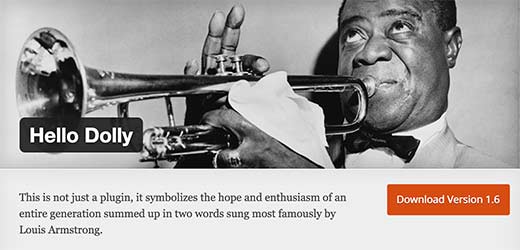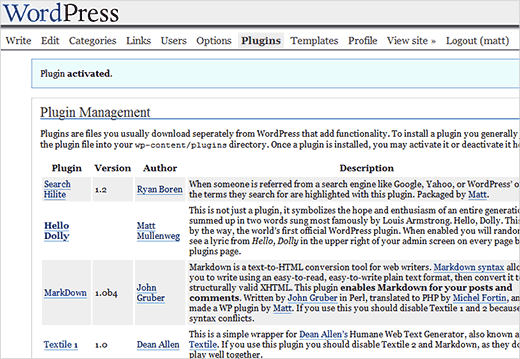Recently one of our users asked what does the Hello Dolly plugin do in WordPress? If you just got started with WordPress, then you probably noticed Hello Dolly comes pre-installed in WordPress with an extremely vague description. In this article, we will talk about what is Hello Dolly plugin and why you should delete it?
Video Tutorial
If you don’t like the video or need more instructions, then continue reading.
What is Hello Dolly WordPress Plugin?
Hello Dolly is a simple WordPress plugin that comes pre-installed in WordPress. If you activate the plugin, it will display a line from the lyrics of Hello Dolly song which is most famously performed by Louis Armstrong.
If you read the plugin description, it is extremely vague and doesn’t explain the usefulness of this plugin.
This is not just a plugin, it symbolizes the hope and enthusiasm of an entire generation summed up in two words sung most famously by Louis Armstrong.
In case you were wondering, YES this plugin is completely useless for all practical purposes.
So why is it there?
History of The Hello Dolly WordPress Plugin
Hello Dolly was one of the very first WordPress plugins to be ever created. It came in May 2004 with the release of WordPress 1.2, which introduced the plugin architecture for WordPress.
Hello Dolly is written by Matt Mullenweg, co-founder of WordPress. Apart from Hello Dolly, there were four other plugins pre-installed in the earlier version. Those plugins were:
- Search Hilite
- Markdown
- Textile1
- Textile2
Since then Hello Dolly has shipped with every version of WordPress.
What is The Purpose of Hello Dolly in WordPress?
Apart from the sentimental values, Hello Dolly has no practical purpose. There have been debates in the community calling for it to be unpackaged from core install however after 11 years it is still part of all default installs.
The current primary reason/excuse for it’s inclusion is that it helps new developers get started with writing plugins.
However in reality, it’s not a very good example to study WordPress plugin development. There are better resources like the plugins handbook and countless other tutorials / videos.
We believe the reason for it’s inclusion as a default plugin is mainly tradition. For many early adopters of WordPress, Hello Dolly is a reminder of the good old days and how far WordPress has come.
Should I Delete The Hello Dolly WordPress Plugin?
Yes, you can definitely delete Hello Dolly without any impact on your site.
Often folks leave it installed and deactivated. In our experience, we have found hackers hiding malicious codes in old default WordPress themes and plugins as it’s the last place most beginners look.
Understand while the default themes and plugins are not what caused your website to be hacked, it’s one of the many spots that hackers usually hide their malicious backdoor code.
We strongly recommend that you delete ALL plugins that you’re not using on your site (not just Hello Dolly).
We hope this article answered your questions about the Hello Dolly WordPress plugin. If you are looking for some really great WordPress plugins to install, then check out these 20 must have WordPress plugins for 2015.
If you liked this article, then please subscribe to our YouTube Channel for WordPress video tutorials. You can also find us on Twitter and Facebook.








Syed Balkhi says
Hey WPBeginner readers,
Did you know you can win exciting prizes by commenting on WPBeginner?
Every month, our top blog commenters will win HUGE rewards, including premium WordPress plugin licenses and cash prizes.
You can get more details about the contest from here.
Start sharing your thoughts below to stand a chance to win!
Jiří Vaněk says
I always automatically deleted the Hello Dolly plugin with every new WordPress installation. I never saw any benefit in it, which you confirmed in your article. However, I never really thought about its purpose in WordPress or why it’s included as a native plugin right after installation. Your article explained it perfectly. Thanks.
Ray Wyman Jr says
I’ve been using WordPress since 2003, when I switched from Greymatter blog (Noah Grey). “Hello Dolly” has been running in the background of just about every WP website I’ve launched since. It is harmless. It does not increase DOM or weigh down performance. And it is a sentimental trinket – a reminder of the old days, which, in my mind, are not so old.
WPBeginner Support says
Thanks for sharing your opinion on the plugin, if you want to keep it active you certainly can on your site
Admin
Alain Guillot says
Thank you. I have several WordPress sites. Only recently I was helping a friend of mine installing her brand new WordPress site when challenged me about the purpose of this plugin. It was nice to show her that this plugin is useless.
shahadat khan says
Oh really help full post thanks for sharing good inform keep up the good work thanks again
Joolz says
Thank you – very helpful and interesting to read the low-down on this plugin’s useful/lessness. Long live “Hello Dolly!”
Lauree Sayne says
Thanks for the info. I’m new to WordPress and I was wondering about Hello Dolly. I’m happy to delete anything not needed and have a minimalist dashboard!
Thanks again,
Lauree
avinash kumar dubey says
Thanks for sharing this concept. can you answer me, how to change howdy name , is this possible to edit. Thanks.
WPBeginner Support says
Please our tutorial on how to change the howdy text in WordPress.
Admin
Mione C says
Thanks for clearing this up! How about older default WordPress themes, though –should you delete those as well? I usually like to keep the most recent, just in case it’s helpful for troubleshooting at some point, but I’ve noticed that most people never delete any of them. What’s your take on that?
WPBeginner Support says
Yes, you should delete old themes that you don’t intend to use. Keeping the latest default theme for troubleshooting and backup is a good practice. However, you can always install them for free whenever you need.
Admin
Richard Buro says
Thank you for the information about the “Hello, Dolly!” Plug-in. It was informative and somewhat nostalgic. I deactivated it after realizing it really was harmless. Your article provided context and depth to my understanding about its longevity and its purpose as an initial test of the plug-in concept in the WordPress environment. As a trained historian, I can understand the desire to maintain a handle on the past. It is commendable, and – in my opinion – a touchstone for remembering the WordPress past while doing in a subtle way. Great article, great history!